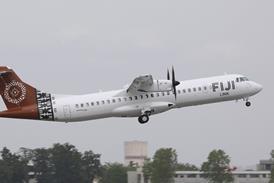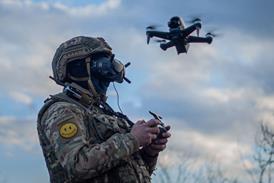Guy Norris/LOS ANGELES
Polar Air Cargo and its older competitors are facing tough times. The Asian economic engine that helped pump Polar rapidly into life is faltering and cargo traffic is down by almost one-third compared to 1997.
Yet the five year old carrier is in good shape to ride out the storm, says president Mark West. "We know we have got to watch our costs. But our best plan is to remain in the marketplace and keep frequencies up. That should see us through this little hiccup. The USA continues to have strong growth, as does Europe, so the hope is that will keep going," he adds.
Polar's strategy is based on extending services to other growth markets in South America, Europe, the Middle East and Africa, consolidating some flights to Asia and keeping its own costs on a tight rein. "Rates will also have to go up," concedes West, who does not believe the move will have "too much impact" on business. Polar also vows to stay focused on serving international freight forwarders and agents, rather than attempt to diversify into delivery or pick-up services.
"We're going to stick with what we do best, which is serving a very large portion of the world's freight forwarders," says West.
POLAR TIGERS
West, along with co-founder and chief executive Ned Wallace, are both veterans of the former Flying Tigers operation. Polar launched operations in 1993 as a three-way joint venture between the GE Capital owned leasing company Polaris Aircraft Leasing, Nedmark Transportation Services (a joint company set up by West and Wallace) and Southern Air Transport (SAT), which provided the operating certificates and crews.
The airline begin operations with two ex-Pan Am Boeing 747-100s leased from Polaris. The aircraft had been stored after Pan Am's failure in 1991 and then converted for the cargo role. Flights began five years ago this month with a charter between New York and Vienna, and was followed in May 1993 with the start of scheduled freight services from New York to Shannon and Moscow. This flight was subsequently extended to Hong Kong and on to the USA, marking the start of Polar's first transpacific scheduled service.
Flights to Sydney and Melbourne, Taipei and Prestwick began within the next few weeks and, by July 1993, Polar was in profit. Within a year, the fleet had grown to nine 747s, flights had been extended to include Atlanta, Seoul and Auckland, while gross sales reached $168 million. During 1994, Polar was certificated as a US all-cargo carrier in its own right and SAT's involvement in the carrier ceased.
In May 1995 Polar was certificated as a US flag carrier and increased its fleet to 12 747s. Sales again grew to $234 million, and new destinations were added, including Buenos Aires, Santiago and Singapore.
Further growth in 1996 was boosted with the expansion of the network to London, Amsterdam and the Brazilian cities of Manaus, Sao Paulo and Rio de Janeiro. The fleet again grew, with the addition of two more 747s, to a total of 14 aircraft, and sales reached $258 million. The airline is now ranked number one US all-cargo airline and the third largest all-cargo carrier in the world.
MANAGING THE FLEET
Polar's burgeoning growth was unexpectedly checked in early 1996, well before the Asian economic bubble burst. Three of the airline's leased 747-100s that had been converted by GATX-Airlog were effectively grounded when the FAA issued an airworthiness directive restricting payloads by almost half. Two of the -100s are stored in Mobile, Alabama, while the third is in Tel Aviv, Israel.
Despite the recent FAA approval of GATX-Airlog service bulletins that will allow the aircraft to return to service with improved payloads, the future of the Polar aircraft remains uncertain. "I see most of our 'newer' aircraft as -200 series freighters," says West, who adds that "a bad feeling" still exists in the industry over the grounding. The three -100s may therefore be returned to Polaris/GE Capital Aviation Services when the leases expire early next year.
The bulk of the existing operational fleet is made up of 10 converted -100Fs and three -200Fs. Five of the -100s were originally converted under the Civil Reserve Air Fleet conversion for Pan Am by Boeing, while the balance were later "special freighter" modifications performed on the same Wichita conversion line. Of the three -200 series freighters, two were originally delivered as dedicated cargo aircraft to Flying Tigers, while the third was built as a Combi for SAS before passing through the hands of many operators before flying for Polar. It was converted to full freighter configuration late in 1997.
Despite the artificial cropping of its fleet, Polar opted to stay with 747s rather than lease in, or purchase, other types. When setting up the operation, several other freighters had been considered. "We looked at DC-8s, L-1011 TriStars and even DC-10s," says West. "The L-1011 is an interesting aircraft, though its range is not superb. The trouble with the DC-10 is that it is not a 'standard' aircraft type in terms of freight pallets, and you have to discount with that. The MD-11 is the same, but it's also expensive. The 747 is a standard. If you want to make it easy for customers, you use 747s."
Despite Polar's obvious love affair with 747s, it is not so enamoured with the -400F. Unlike one of its major competitors, Atlas, it has no plans to move up to the biggest freighter on the market. "We are a low cost provider, and that's the way it has got to be. The -400 does not fit with our rotations. The -400 is much better on non-stop routes like Los Angeles-Hong Kong, but the problem with that is that then we'd overfly Anchorage and lose out on our east coast cargo collection point," he explains.
The fleet was bolstered by the arrival of the third -200F on 26 March, from the Matrix Aeronautica site in Tijuana, Mexico, where it had been extensively overhauled after a mercury spill while in service with its former operator, SAT. The aircraft received a C check, Section 41 modification and engine pylon rework. Like one of the other -200Fs, the former Southern freighter is powered by the more powerful Pratt & Whitney JT9D-7Q and is now operating Polar's routes to China.
March also saw the first Polar aircraft enter service fitted with Traffic Alert and Collision Avoidance System II (TCAS II). Polar says that by the end of this year it will be the first major US scheduled all-cargo operator to equip its entire fleet with TCAS II systems. "Although TCAS II is not mandatory for all-cargo aircraft under current FAA regulations, we have taken this step in the interests of our employees and a higher level of safety," says Polar vice-president of maintenance and engineering, Dick Scholl. "Increased air traffic worldwide, particularly over North America and Europe, as well as limited navigation facilities in more remote parts of the world, led us to conclude that we should act to invest in this safety technology well in advance of any new requirements."
CHANGING STRATEGY
Polar is introducing a series of tactical and strategic moves to counter the "soft" Asian market. Tactical changes include shifting capacity and relocating to other destinations. "We've never had to do that before," says West. "We're consolidating some of our flights. What was formerly a Hong Kong only flight is now Hong Kong and Taipei, so we are picking up more origin points."
Strategic changes include "holding off" on planned expansion routes to Jakarta and Penang, while sticking to the opening of new services to Manila and Tokyo. The Philippines service is due to begin in April and will be joined shortly after by the Tokyo-Narita flight - Polar's second Japanese service after its Kansai operation. Japan continues to play a vital part in Polar's strategy. The airline is only the third US all-cargo carrier with scheduled services to Japan, providing a profitable link for freight forwarders and agents, says Polar.
Using its Amsterdam cargo centre as a spring board into Africa, Polar also plans to expand into untapped territory on a route linking Jeddah, Nairobi, Harare and Johannesburg. A similar expansion is also planned for this year, into South America where Caraças, Venezuela, will be added. Polar is also paying close attention to possible expansion in India.
Despite this positive growth in other areas, the Asian situation remains a worry to West. "It's a tough business. Some 98-99% of the business is international, and a big chunk is Asian. The movement of cargo is also unbelievably down, and people will trade away fuel price reductions - that's what bothers me," he adds. Fuel prices are at a nine-year low, while cargo traffic is estimated at 25-35% lower levels, depending on market parameters. The aggression of Asian carriers, which are desperate to fill their cargo holds, also poses concern to West.
West is also cautious over rumours of an early revival. "Every day we seem to be on the road to recovery, but then you get news that kicks you. Unfortunately, there are still many negative signs and the stock market is a barometer of the lack of confidence. We shall see what effect the various austerity programmes, or those that the IMF [International Monetary Fund] are putting in place, will actually have. In the meantime, we're riding out the storm," he says.
Source: Flight International























